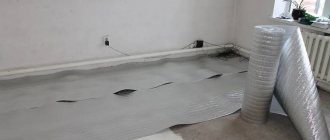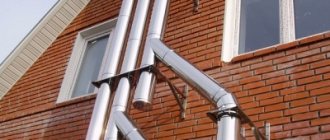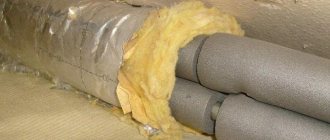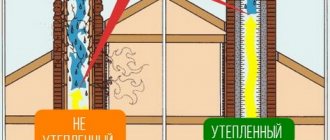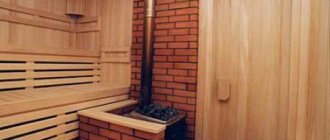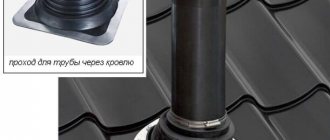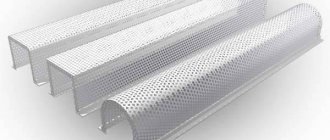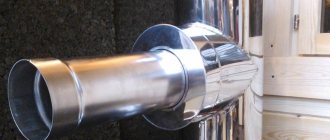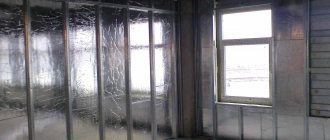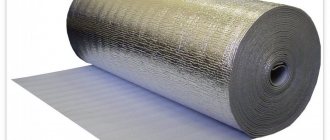Why insulate
For proper operation of furnaces or boilers, it is necessary that there is good draft in the pipe. This is especially important when using periodically heated stoves. When the chimney is cold, it is very difficult to immediately light a fire in the firebox. This is explained by the fact that cold air tends downward, and warm air tends upward.
If the height of the chimney is large, then it contains a lot of cold air, making it difficult to ignite. If the cross-section of the chimney channel is small, it is recommended to first burn some wood in the firebox, and then, as it warms up, load it with the calculated amount of fuel.
The soot that forms on the walls of chimneys also limits draft. It is formed if the temperature of the gases is not enough to ensure complete combustion of volatile fuel particles. At a low temperature of the chimney walls, condensate containing soot particles, products of incomplete combustion of fuel, is deposited on them.
When soot accumulates in the chimney, it may ignite, especially during subsequent intensive combustion. In this case, the temperature in the pipe can increase many times and metal pipes can simply burn out.
In addition to soot, condensate contains carbonic and sulfuric acids, which are chemically aggressive substances and can destroy pipe walls.
The above problems with the chimney can be avoided if you insulate it from the outside. Then the walls will heat up much faster, and there will be no soot formation during combustion.
If units with internal combustion engines are used in the operation of buildings, for example, gas generators for autonomous power supply, then the exhaust pipes that go outside must also be insulated to prevent the formation of condensation and soot.
Of course, to ensure fire safety, you need to use only non-flammable chimney insulation that is quite effective and durable.
Why does the chimney need to be insulated?
In the case of a chimney, insulation is not quite the correct term; in fact, we are talking about thermal insulation. It must be done to prevent rapid destruction of the chimney pipe. There are several reasons for this:
- Along with the smoke, moisture enters the chimney and settles as condensation on the walls of the chimney. This leads to the destruction of the material. The greater the difference between the external and internal temperatures of the chimney, the faster condensation will destroy the pipe.
- Water vapor mixes with combustion products, forming aggressive compounds in the form of acids. They also settle on the walls of the structure, gradually destroying the material and shortening the life of the chimney.
- An uninsulated chimney is subject to periodic expansion when heated and contraction when cooling due to the low ambient temperature. This is another reason for destruction.
Without thermal insulation, the destruction of the chimney occurs much faster
Steam compounds with combustion products are poisonous. If they enter a room, they can cause poisoning to the inhabitants.
The essence of chimney insulation is to create a heat-insulating barrier around the pipe, reducing the temperature difference with the environment. First of all, areas passing through unheated rooms and located outside the building should be insulated.
Insulation rules
Depending on the material, chimneys can be:
- brick;
- steel;
- ceramic.
Be sure to insulate with non-flammable material only those areas that come into contact with cold street air.
It is also possible to insulate parts of pipes running in unheated attics.
It is not advisable to insulate parts of chimneys passing inside heated rooms, since they are an additional source of heat. An exception is made for metal pipes, which become so hot that you can get burned if you touch them. But even in this case, sometimes it is enough to fence off such areas of the chimneys with mesh screens. Often such solutions are used in village baths.
Steel chimneys must be insulated in any case, and the thickness of the layer of non-combustible thermal insulation should be as large as possible. Brick pipes with a wall thickness of brick (25 cm) or more may not be insulated if the air temperature does not drop below -20℃.
Ceramic chimneys are usually made from products that have a honeycomb structure. Such blocks themselves are thermally efficient and do not require insulation.
For thermal insulation, only non-flammable, heat-resistant materials are used, ensuring high fire resistance of the entire building. The value of the fire resistance limit of pipe insulation must not be lower than EI 45.
Fireproof wall coverings
To prevent spontaneous combustion of the walls adjacent to the furnaces, it is necessary to install special cladding made of non-combustible materials with thermal insulation properties.
Thermal insulation for furnaces in this case is carried out in two ways:
- For cladding, materials are used that have reflective properties and are resistant to high temperatures.
- The heat-insulating furnace casing is covered with a lining of heat-resistant tiles.
Good reflective qualities are shown by metal sheets covering non-flammable heat-insulating sheets. It is best to use stainless steel, since galvanized steel releases toxic substances when heated.
It is recommended to polish the outer surface of metal sheets, as this helps to better reflect thermal energy.
The following materials are used as thermal insulation:
- basalt cardboard;
- basalt wool;
- minerite;
- asbestos cardboard.
In accordance with SNiP 41-01-2003, installation of the casing is carried out in the following sequence:
- Installation of insulation with a ventilation gap of 2 to 3 cm. The thickness of the insulating material is no more than 2 cm and no less than 1 cm.
- Installation of metal sheet.
- Maintain a distance between the stove and the casing of at least 38 cm.
Ceramic bushings are used to attach materials to the wall: they allow the required gap to be maintained and are resistant to fire. If it is not possible to maintain the specified distance between the stove and the casing, then two layers of thermal insulation sheets should be used. For example, two sheets of mineralite are attached using ceramic bushings. The distance between them is 2-3 cm. The outer sheet is covered with stainless steel.
The design of a room or bathhouse does not always allow the installation of metal cladding. Often it will not fit into the interior of the room. In this case, you can resort to sheathing with heat-resistant tiles, which are attached using a special adhesive that is resistant to high temperatures. We list the suitable materials for cladding:
- terracotta tiles;
- porcelain stoneware;
- tiles;
- clinker tiles;
- Soapstone chlorite
When installing, follow the following rules:
- The ventilation gap between the wall and the fireproof sheet should be 2-3 cm.
- Fire-resistant tiles are attached to the installed sheet using special adhesive mixtures.
- The oven should be located no closer than 15 cm from the surface of the tile.
The following are suitable sheet fire-resistant materials for cladding with cladding:
- minerite;
- fireproof plasterboard containing fiberglass;
- glass-magnesium sheet.
The cladding will help not only to complement the design of the room and maintain a unified style, but also to reduce the permissible distance between the stove and the wall.
Advantages of an insulated chimney
An important stage in designing a warm house is organizing thermal insulation of the exhaust duct inside and outside the house. Vapors and soot adhere to the internal surfaces, combine with condensate, and corrode the internal coatings of the channel.
Modern houses are heated by automatic heating systems that switch over and over again, the system heats up and cools down to a certain temperature. With this mode of operation, condensate and combustion waste become several times larger, which leads to rapid destruction of the smoke exhaust channel.
There is only one way out: find out how to carry out proper thermal insulation, which one to buy and apply the insulating base.
Insulating the chimney will reduce heat loss and help:
- provide good ventilation in the duct;
- get rid of freezing;
- reduce the process of settling of resins and vapors on the canal walls;
- will reduce repair costs and heat loss.
Making thermal insulation with your own hands is not difficult, but the main thing is to know how to insulate a metal chimney pipe or brick duct. For use, there are special non-flammable substances used for household and professional thermal insulation.
Energyflex pipe insulation
Has its strengths and weaknesses. The advantages include strength, moisture resistance, and immunity to temperature changes. The material does not cause difficulties during installation and is light in weight. The layer thickness can be from 9 to 13 mm, length - up to two meters. Suitable for pipelines with diameters from 18 to 160 mm. The flexible material can be laid in areas with complex geometries.
Energoflex does not require additional wrapping with roofing felt. The disadvantages are the high cost and the impossibility of installing it where the temperature of the pipeline working environment exceeds 100°.
- If you are purchasing roll insulation, make sure that it is intended specifically for pipes before purchasing.
- The rigid material in the form of semicircles is sized to fit onto a pipe of a specific diameter.
- A distance of 2.5 cm must be maintained between the wall and aluminum foil.
- The price of insulation is affected by both the thickness of the reflective layer and the base material.
- There is a significant difference between aluminum plating and aluminum foil. In the first case, the heat insulator will work less efficiently, its reflectivity is low.
Application of bricks
One of the old methods of making non-combustible thermal insulation for metal pipes involves the use of broken refractory or clay bricks.
In this case, a steel casing was created around the pipe so that the gap between it and the pipe was about 50-100 mm. The broken brick is poured into this gap. The brick does not need to be compacted and compacted to create thermal gaps. This method of insulation is inexpensive, because it practically does not require special purchase of materials. The disadvantage is the large weight of the entire pipe structure, which negates all other advantages of metal chimneys - quick erection, mobility, the ability to create any configuration.
Features of chimney insulation with basalt wool
In addition to the correct choice of basalt insulation, you need to worry about compliance with installation rules. As practice shows, the following norms are especially often violated:
- The thickness of the basalt wool layer in penetrations through wooden structures is at least 5 cm. The distance from load-bearing beams is at least 1 m.
- If you need to lay the material in several layers, correctly lay out the fire-resistant basalt slab with an offset to overlap the joints of the bottom sheet with the top sheet. The same rule applies when installing cylindrical insulation. The longitudinal seam of each subsequent shell is shifted by 180°.
- The installation of a chimney passage through a wooden ceiling using basalt wool involves the use of fire-resistant cutting. There should be a distance of 50-100 mm from the heating surface to the flammable material. The gap is filled with stone wool.
The thickness of the basalt fiber in the chimney should be no more than 40 mm, for external insulation, up to 100 mm. Density is selected depending on operating conditions. To insulate ceramic chimney pipes connected to solid fuel boilers, basalt wool with a density of 100 to 200 kg/m³ is used.
- There is no point in using high-temperature basalt wool for thermal insulation of a chimney connected to a gas or liquid fuel boiler, since the temperature of the exhaust gases rarely exceeds 200-300°C. It would be optimal to install cylindrical insulation.
- Calculation of the required amount of basalt wool for insulation of a steel chimney. The required thickness of the material is selected. The insulation packaging indicates the approximate consumption of cotton wool for different layer thicknesses. All that remains is to calculate the size of the circle in centimeters and the length of the pipe. After this, the number of packages is calculated.
- After insulating a single-layer pipe with non-foil material, it is necessary to manufacture a protective structure.
- Low thermal conductivity - even at flue gas temperatures above 500°C, basalt wool heats up to no more than 30°C. During a short-term ignition of soot and a temperature jump to 900°C, the outer contour of the sandwich pipe will not heat up more than 45°C.
- Non-flammability - the material can withstand the impact of directed fire from a gas burner without igniting. Cotton wool begins to melt after exceeding 1100°C. Therefore, you can lay basalt insulation close to the chimney pipe and not worry about the safety of the room during the entire period of operation.
Pros and cons of using basalt for chimney insulation
The main disadvantage of basalt insulation is its cost. Otherwise, compared to any other types of thermal insulation, basalt undoubtedly wins. The advantages of the material include:
Infrared radiation passes through most insulation without hindrance. Thermal insulation for pipes with foil is highly reflective and retains heat much more effectively than materials without a protective layer.
According to average statistics, a building loses from 40% to 70% of thermal energy in winter. Heat loss occurs for three reasons: due to the high thermal conductivity of the pipe material, due to convection and due to infrared radiation. Heat transfer can be stopped by reflection.
You can purchase foil insulation for pipes, or you can wrap the insulating layer with foil yourself. This insulation is sold either in rolls or in the form of hollow tubes. The foil is laid with the front side out. It is important to ensure a gap of 1-2 cm between the foil and the pipeline. The disadvantages of foil are its fragility and susceptibility to aggressive substances. The top protective layer transmits about 10% of the energy.
Non-combustible thermal insulation: insulation of brick, asbestos-cement pipes, stainless steel chimneys
The need to insulate high-temperature routes has arisen since their inception. And if the insulation of pipelines was solved quite simply - they were buried in the ground, then the insulation of chimney pipes caused a number of difficulties. And they were associated primarily with the danger of fire of the heat insulator itself. This is why non-flammable thermal insulation for chimneys is a priority when choosing insulation.
The insulation of pipelines was solved quite simply - they were buried in the ground, but the insulation of chimney pipes caused a number of difficulties. And they were associated primarily with the danger of fire of the heat insulator itself. This is why non-flammable thermal insulation for chimneys is a priority when choosing insulation.
For information! In some sources you can read that such a layer is possible without reinforcement, but I would still like to remind you that reinforcement is an element of strengthening, and the layer that you leave will serve as a shield for the pipe, while independently taking on themselves against all temperature fluctuations and aggressive atmospheric influences. Therefore, the stronger the structure, the longer and without problems it will serve.
- Next comes the application of the plaster itself, which must be prepared in two consistencies: pasty and more liquid. Layers are applied one after another, the last being a thick layer, which is leveled and whitened with regular whitewash.
Also suitable for a brick wall are basalt wool mats, foam glass and any other non-flammable thermal insulation material, and the technology will be as follows:
- The pipe is wrapped in insulation: either mats of basalt wool (foam glass) are attached to umbrellas, or a roll is wrapped around the pipe and fixed with wire;
- Next, either prepare another brick box around the pipe, followed by sealing the gap between the main pipe and the casing with cement mortar;
- Either the insulation is wrapped in foil, the lower joining part is cemented to form a cement pad, the joints and seam part are closed with special foil tape.
insulation of brick pipes is as follows:
- At the end of all work, we need to get a layer of 5 cm, this will be quite enough for pipes, so we clean the pipe itself from dirt and unstable layers and reinforce it with a coarse metal mesh;
All the technologies we have described are quite simple, one might say economical, and easy to do with your own hands.
Pipes made of so-called stainless steel
The same materials are used for steel chimneys as for asbestos-cement pipes. Laying technology, materials, fastenings, all this is reminiscent of the previous chapter. Only in this case there are ready-made solutions that you can choose and not suffer. These are the so-called sandwich systems, when the pipe is already in the pipe, and non-combustible insulation is inserted between them.
General recommendations for carrying out work
Warming is a necessary process.
Whatever technologies you choose for insulation, there are general recommendations that, for some reason, are lost in the general cacophony of advice, but which are still worth listening to in order to avoid many embarrassments. So:
- As you have noticed, in all works it is proposed to seal the bottom edge in a cement base, before carrying out such work, make sure that the roof base allows it to be done;
- When carrying out insulation, keep in mind that neither the insulation nor the casing (if any) should come into contact with the roof. That is, it is necessary to think through the docking and drainage system;
- When purchasing adhesive mixtures for fixing the same basalt wool or foam glass, as well as adhesive tape for fixing insulation, pay attention first to the area of application, and then to the price, and not vice versa. The fact is that heat-resistant materials will initially be more expensive than conventional ones;
- When choosing a thermal insulation material, consult the seller about the possibility of using the material. Although the material is imported specifically for your region, sometimes thinner insulation is left behind. Just keep in mind that for insulation work, a material of at least 40 mm is required;
- More complete information may be in the accompanying documents for the material, as well as on the packaging, the official website of the manufacturer, do not be lazy to look at the information.
Why is thermal insulation needed?
The role of the thermal insulation material is that, due to its poor thermal conductivity, the transfer of energy through the layer of material is difficult. Thus, you can not only preserve the heat that the fireplace produces, but also protect the structural elements of the house from high temperatures.
Chimney insulation serves several purposes.
- At the external location of the pipe, intense heat exchange occurs with the cold air of the street space. A huge part of the amount of heat is released into the atmosphere, but could be used to heat the room. If you reduce this share, you will achieve higher efficiency indicators. The solution to this issue will be insulation, which is applied on top of the walls of the chimney.
- Combustion products that are emitted through the chimney contain carbon dioxide and water vapor. The temperature of all this gas exceeds a hundred degrees. Upon contact with the chimney walls, which have cooled from the external environment, condensation forms on the surface of the latter. Acids, which are a combustion product, are mixed into it. The result is a chemically active environment, leading to the destruction of the walls. The appearance of condensation can only be avoided by increasing the temperature of the pipe itself, that is, by providing it with high-quality insulation.
- In places where the chimney pipe passes through the ceiling or roof, contact of materials necessarily occurs. In the case of wooden buildings, this situation is a fire hazard. But an additional function of insulation will be to protect the ceiling surfaces.
Corner placement option
Internal insulation of fireplaces implies the localization of energy inside the firebox for the purpose of its directed transmission. The fireplace should not emit heat in all directions, especially if it is installed near a wall. It should warm those sitting directly in front of the fireplace. Special reflectors for fireplaces are installed inside the firebox and serve as a screen from infrared radiation. As a result, all the heat escapes through the combustion hole into the room.
Reliable thermal insulation for stoves and fireplaces means protecting the walls of the building from the negative effects of temperature. When the fireplace is located close to the wall, a heat-protective layer is installed, since high temperatures can lead to destruction of the brickwork of the wall or fire if the building is wooden.
How to make non-flammable thermal insulation of chimneys
When fuel burns in stoves and fireplaces, carbon monoxide is formed. They are removed through the chimney. Despite its apparent simplicity, this design is complex. Chimneys are installed to provide the necessary draft, so they should be correctly brought to the roof, the height determined and connected to the roofing. Properly made thermal insulation for chimneys is also important.
Reasons for insulating chimneys
Furnace gases escaping from the furnace to the outside have a high temperature. When they rush up the chimney channel, condensation forms on its inner walls. This leads to the following problems:
- if moisture is absorbed into the chimney material, it will deteriorate over time;
- sometimes droplets of water settle on the surface of the outlet channels, which reduces their permeability and allows smoke to leak into the room;
- when condensate constantly flows down the walls of the chimney, smudges, hanging drops and an unpleasant odor appear.
Thermal insulation of the chimney helps to avoid these troubles and extends its service life.
Note! The chimney is insulated to prevent rapid cooling. If you do it incorrectly, you can’t count on a positive result.
Methods for insulating furnace ducts
How to isolate the furnace channel depends on the material from which it was made. You can make insulation using:
- crushed bricks;
- slag;
- expanded clay;
- basalt or mineral wool;
- kaolin, etc.
After installing the containment shell, the smoke exhaust structure is lined. For this purpose it is used:
- brick;
- slag concrete and reinforced concrete slabs;
- galvanized metal casings;
- wooden boards;
- profiled sheet, etc.
On a note! The easiest way is to buy a ready-made insulated sandwich pipe and install it at the stage when the chimney is being built.
Let's take a look at some thermal insulation options separately.
Basalt wool insulation
This method of protecting chimneys is attractive due to its accessibility and is therefore used more often than others. Basalt wool has a thickness of 20-100 mm and can withstand temperatures up to 750 degrees. This fire-resistant material is wrapped in several layers around the pipe and secured with wire. A layer of plaster is applied on top.
Lining the chimney with stainless steel sheets is done in the following order:
- measure the perimeter of the pipe, including insulation;
- cut a piece of sheet steel up to one meter long and a width equal to the perimeter of the structure plus an allowance for fastening;
- round the sheet and finish the edges with a roller;
- put the resulting form on the stove chimney, pull it together and fasten it with metal screws;
- In the same way, install several more metal casings on top of each other (make sure that the seams run at an angle of 120˚).
On a note! If you do not use steel casings, the insulation will not last long and you will have to replace it. Even if you insulate the chimney with foil or film, they will not be able to prevent moisture from penetrating into the basalt wool.
Applications of kaolin
Another method of thermal protection of chimneys is the use of kaolin. The material is characterized as:
Work on installing non-flammable thermal insulation for chimneys is carried out in the following order:
- first plaster the stove channel;
- then glue kaolin sheets to the wet plaster;
- Finally, sew up the chimney with facing material.
Insulation with mineral wool
Thermal insulation using mineral wool is done as follows.
- Build a metal profile sheathing around the chimney. The profile size is selected depending on the thickness of the insulation, and the lathing pitch depends on the width of the insulating sheets.
- Attach mineral wool to the profile in several layers (do not forget to space the seams).
- Wrap the finished structure with vapor barrier film and seal the joints with tape.
Note! Sheets of metal corrugated sheets can be used as finishing. They are fixed to the sheathing using special screws with rubber gaskets.
How to insulate a chimney also depends on the material from which it was made.
Chimneys - nuances of insulation
Thermal insulation of steel pipes
The chimney, made of a round steel pipe, is insulated using a ready-made metal case. Large diameter galvanized pipe is suitable for this purpose. The difference in the diameters of the chimney and insulation is 16-20 cm. Thermal insulation is installed in this way.
- Place the casing on the steel chimney.
- Pour expanded clay, broken brick or slag into the space formed between the elements. You can also compact mineral wool, basalt wool or fiberglass between the pipes.
- Fill the open area with cement mortar, waterproof it and install a protective casing on top.
On a note! The profile steel pipe is sheathed using wooden panels or metal sheets (corrugated sheeting). The distance between the components of the structure is 8-10 cm. The space is filled with insulation and securely sealed on top.
Insulation of brick chimney
In this case, preference is given to mineral wool, which is attached as follows:
- cut out pieces of insulation the size of which corresponds to the area of the side walls of the pipe;
- attach the blanks to the brick using plastic dowels with round heads, or use tape (this option is lightweight, but not reliable);
- cover the attached material with asbestos-cement slabs, corrugated sheets or bricks.
Important! To reduce heat loss, plaster the brick on the outside of the channel, and then cover it with a frost-resistant compound.
Thermal protection of asbestos-cement pipes
Insulating chimney pipes from asbestos cement is done like this.
- First, clean the outer surface of the chimney from dust and dirt.
- Make a folding metal casing consisting of two halves. When assembled, its diameter should be 12-16 cm larger than the diameter of the pipe. The height of the case can vary within one meter.
- Place the bottom galvanized casing on the chimney.
- Fill or compact protective material into the resulting space.
- Install the next case and reinstall the insulation.
- Cut the top casing together with the asbestos cement pipe at a slight angle.
- Cover the insulation with a thin layer of cement mortar.
On a note! If you do not install a metal case, the mineral wool will become wet, heavy, crumpled or frayed in the wind. Birds, rodents or cats also take away the insulation.
Insulation of the chimney in the ceiling
When a metal chimney passes through a wooden ceiling, the distance between them must be at least 30 cm. If the chimney is lined with brick, then this value is reduced to 10 cm. The opening is filled with basalt wool and closed from below and above with a metal sheet. Make sure that the chimney is securely fastened to the ceiling.
Thermal insulation for chimneys: types of insulation and methods of protecting chimneys, Portal about pipes How to insulate a chimney - non-flammable thermal insulation. What materials are used to insulate chimney pipes in the ceiling? Methods and nuances of insulating structures made of
Carrying out work
The technology for thermal insulation of a fireplace consists of a step-by-step solution to certain problems.
Setting tasks and solving them
- The required amount of material is calculated. For more efficient use, take into account the cutting and processing ability of the insulation boards or fabric.
- If the fireplace is located at a distance not exceeding 50 cm from the wall, then sheets of insulating fiber are attached to its walls.
- The degree of insulation can be increased using a multilayer structure.
- The chimney is insulated, regardless of what material it is made of.
The characteristics of modern insulating materials will help answer the question, how to properly insulate a fireplace? To insulate walls, it is advisable to use slabs, one side of which is covered with foil. The foil creates a protective screen, and the effectiveness of such protection is quite high. A negative quality is the unaesthetic appearance of slabs made of insulating material.
In wooden buildings, it is recommended to use several layers of insulation. To do this, a lathing is made of metal slats into which gypsum fiber boards are inserted. A wooden sheathing is mounted on top to secure sheets of fire-resistant plasterboard. The outside surface must be finished with tiles or artificial stone.
Several technologies are used to perform chimney thermal insulation. One of them is making a sandwich pipe. A box is made of metal, which has a larger diameter compared to the diameter of the chimney pipe. Mineral wool is laid along the walls of the box. Then a pipe of smaller diameter is inserted inside. When manufacturing the structure, it is necessary to provide for the option of wrapping the pipe in parts.
The brick pipe is insulated with plaster, which is applied in several layers on all sides. After the fourth layer, the outside of the pipe is lined with mineral wool slabs. They are fastened with self-tapping screws with large washers. The outside must be made of brick; it will give an aesthetic appearance to the pipe and protect the material from precipitation.
Do-it-yourself insulation installation
Before starting work, you need to learn the basic rules for applying insulation, and learn how to insulate an iron chimney pipe yourself. Insulation carried out according to the rules will allow the owner not to violate the construction technology and not worry about reducing the draft in the chimney.
Required tools and materials
For installation work on insulating a chimney pipe from the outside, you will need a set of tools that are available in every household: a tape measure, a screwdriver, a grinder, self-tapping screws, metal scissors, a knife for cutting insulation, and protective equipment.
Calculation of the dimensions of the structure
To properly organize the work, you need to calculate the construction parameters and costs. The heating temperature of the inside of the outlet channel, as well as the insulating layer, depend on what type of fuel is used.
The amount of insulation is calculated according to the measurements taken:
- external parameters of the insulated surface;
- height of the structure;
- distance from the lower outlet of the pipe.
For example: on a cold roof and above it, the outlet from a solid fuel heater is wrapped with a layer of 5 cm to 10 cm. The distance on the chimney from the ceiling to the roof in an insulated attic is insulated with a layer of up to 6 cm. The exhaust structure from a gas boiler is insulated with a layer of 3 cm.
The insulation consumption for a chimney for a solid fuel boiler will be, for example, as follows: with its height of 5 m, diameter 219 cm, basalt cylinders need 5 linear meters with a layer thickness of 5 cm, parameters for the internal diameter. Sheet insulation will require 3.5 m². For the protective casing, buy galvanized steel, 2.7 cm thick.
The height of the protruding end depends on the distance of the channel to the roof ridge. Located at a distance of 1.5 m from the center of the house, the chimney should be 50 cm higher than the ridge. Two meters from the center - the height at the level of the ridge, three meters on pitched roofs - the height is determined at an angle of 10°, between the line of the horizon and the ridge.
Work progress
Before installation, you will need to buy chimney sections, anti-corrosion agent, insulation, brackets and clamps, heat-resistant sealant, moisture-proof fabric, galvanized cladding, profiles for the frame, asbestos sealant, fire-resistant foam.
- Before using the insulation, an anti-corrosion substance is applied to the pipe. A protective film is formed on the surface, which protects the metal from destruction for a long time. Combine and secure the parts of the pipe so that moisture does not enter the joints when draining. The connection should be 5-7 cm long for stability.
- After connecting the segments, the metal pipe is wrapped with insulation. The edges of the insulation are wrapped overlapping and secured with steel clamps or aluminum wire. Externally insulated wire cannot be used. Under the influence of high temperatures, the insulation will melt, the fastening strength will weaken, which will lead to deformation of the winding.
- The soft surface is covered with a vapor barrier fabric, and sheets of galvanized steel are fixed on top of it. The galvanizing is fixed with an overlap, from bottom to top, with an overlap of 7-10 cm, fixed with clamps every 30 cm.
- A hole is cut in the roof, which corresponds in diameter to the insulated chimney.
- Under the roof and on the outside of the ceiling to the rafter structure, a horizontal fastening is installed to stabilize the chimney.
- The gaps between the roof and the structure are sealed with heat-resistant non-combustible materials, blown in with heat-resistant foam, and covered with a metal casing.
Stainless steel casing
Thermal insulation of the furnace using stainless steel casing has several options. Based on orientation in space, front and side screens . The recommended distance from the oven to the screen is from 1 to 5 cm . Thanks to such structures, it is possible to reduce the intensity of thermal radiation from a metal furnace, since the outer surface of the protective screens warms up to 1000 C. In this case, it is possible to reduce the distance from the furnace to the wall to half a meter. Ease of installation and the presence of special legs that allow you to securely fasten the screens make their use especially attractive.
Basic methods of insulation
We have already discussed the insulation of a metal chimney in particular above. Determine what the casing in the ceiling and on the roof will be made of. Pay special attention to places of insulation near the outlet of the pipe; in those places the greatest temperature difference is observed.
Method of insulating a steel chimney
There is no particular difference between the insulation of a stainless steel channel and the like. Also pay attention to the transition directly in the house, as well as in the insulated part of the roof. Often, many owners are careless about arranging a channel in the attic, but in most cases it is from there that the fire begins to spread. According to the advice of many experts, it is better to completely thermally insulate the channel in an unheated room.
Gas boiler flue insulation
In this case, the same places that were discussed above need to be insulated. You can use the same materials for this as for solid fuel boilers. That is, opt for basalt or asbestos-cement slabs, with a layer of “stainless steel” covered on top.
Tips from the pros
In order to increase the fire safety of the ceiling that crosses the chimney or chimney, install a decompression chamber by installing a heat-insulating board in a horizontal position.
It is preferable to provide 2 fan grilles in the box : one for the purpose of cooling the decompression chamber, and through the other, warm air will be transmitted throughout the room. Sheets of plasterboard are attached to the iron guides using self-tapping screws: they will be the basis for the decorative finishing of the fireplace.
Expert advice
Install a smoke exhaust channel according to the rules. It is also worth taking advice from experts. Thermal insulation is carried out according to the following standards:
- thermal insulation must be applied in a continuous layer, without transitions, especially in places of contact with the ceiling and roof;
- mats and strips are laid only with the markings facing outwards;
- installation of parts is carried out from the bottom up, overlapping, the lower end is covered with the upper connection;
- internal insulation is carried out in stages, during installation of the structure, external insulation after complete assembly;
- a spark arrester is installed at the end if the roof consists of flammable materials;
- use personal protective equipment.
The rules are simple; following them will help prolong the operation of the output channel.
Thermal insulation for pipes with foil
Heating and sewerage
Rockwool cylinders are the best solution for heating pipes, ventilation ducts, air conditioners and sewer pipes. This flexible foil pipe insulation is resistant to chemical irritants and is easy to install. Covered with a protective layer, the casings are strong and durable.
- First, cut out sections of the required length. The segments are joined closely to each other.
- Then 2 fasteners are installed on each segment with a distance of 500 mm between them.
- For vertical sections, retaining rings are used that prevent the cylinders from slipping over time.
- For curved pipes, the cylinder is trimmed by fitting the hole along the pipe.
Types of basalt insulation for thermal insulation of chimneys
The choice of brand of basalt wool depends on the desired thermal characteristics. The material is selected depending on the operating characteristics and the type of chimney design. You will also have to decide on suitable insulation for the manufacture of roofing trim and assemblies for passing through the wall, and the floor slab.
Basalt thermal insulation shells (cylinders)
When installing pressed basalt cylindrical insulation, they are guided by the requirements set out in SNiP 2.04.14-88, and specifically by the following instructions:
The cylinders have a longitudinal seam for easy installation on pipes. The insulation is secured with bands made of thin-sheet galvanized or stainless steel, with a thickness of at least 0.8 mm. As an alternative, tie wire made of stainless or black steel is used, with a diameter of 1.2 and 2 mm, respectively.- Non-flammable basalt heat-insulating elements of the cylinders are installed at intervals along the seams. The joints are insulated with aluminum tape.
- Installation work starts from the flange. Foil insulation does not require a protective coating. In other cases, a casing or metal casing is made for insulation.
Choice of insulation
It is immediately important to divide the insulation into 2 groups:
- Independent - which does not require additional protection and steam and waterproofing. These include cylinders for insulation (shells).
- In need of protection – protection from the external environment is required. These include basalt wool for chimneys, EPS and the like.
Before making a choice, it is important to consider several factors:
- What is the temperature of the outlet gases? The higher, the less the pipe needs insulation, but the material must also be heat-resistant and fire-resistant. Accordingly, a thinner layer of thermal insulation can be used.
- The chimney is located inside or outside. If the entire pipe runs along the outer wall of the house, it needs especially high-quality insulation. It takes longer to warm up, which means more moisture condenses during this time.
- What is the chimney made of? If the pipe is metal, it can be insulated using heat-insulating cylinders. Brick - with basalt wool or even EPS.
So, these were the general rules that help you choose how to insulate your chimney. Now let's move on to a direct examination of each of the main materials for insulation.
Advice. Before carrying out work, make sure that all sections of the chimney are securely connected, especially if it is made of metal. Thermal insulation material is not able to prevent the fire of wooden roof elements
Thermal insulation cylinder
Let's start with this material, which closes the question of how to insulate a metal chimney. It consists of 2 pipes, one of which is of a smaller diameter and plays the role of a chimney itself. Usually it is better to take it from high-quality stainless steel with special additives that make it resistant to aggressive acids that form in the chimney. The outer pipe is larger in diameter, at least 6 cm. It plays the role of a protective casing. Basalt insulation is placed in the distance between these pipes. The result is a “sandwich” that is light in weight and size.
You can make such “sandwiches” yourself, or you can purchase ready-made shells for insulating chimneys.
When making such a heat insulator with your own hands, you should take into account several requirements before insulating a metal or asbestos chimney pipe:
- The thickness of the insulation layer for a stainless steel pipe should not exceed 10 cm.
- If the temperature of the outlet gases is high in the pipeline, loose basalt wool should be used. This is a non-flammable material. It does not contain binders, and the combustion temperature rises to 900 degrees.
ATTENTION It is strictly prohibited to use asbestos pipes for high-temperature heaters. Soot accumulates well in such a pipe due to the rough inner walls. At high temperatures, soot can ignite and create excess pressure in the pipe. In rare cases, an explosion may occur inside the pipe.
If we talk about insulating an asbestos pipe, it is practically no different from a metal one. It needs more thermal insulation due to the fact that it absorbs moisture better than metal.
Some people make the following mistake. Most often, when you need to create a temporary chimney. Purchase insulation for chimneys, for example, basalt wool in rolls or mats. The chimney pipe is wrapped with an overlap and the insulation is fixed with metal tape or even ordinary tape. You can't do that!
Any mineral wool must be protected from water and wind. If you leave it open, after a while part of it will be blown away by the wind, and part will be crushed under the influence of precipitation. If you want to insulate, be sure to provide a protective casing. For example, make it yourself from ordinary galvanized iron. In this case, mineral wool, as insulation for a chimney, will last quite a long time.
Mineral wool
By mineral wool we mean basalt (stone) wool, because... it has higher fire resistance ratings. Therefore, it is recommended to use it for insulating chimneys with high temperature exhaust gases.
It can be used both when insulating a chimney inside the attic and outside. If we talk about the attic space, then the chimney can simply be covered with cotton wool mats and secured with metal strips or a rope. Because There is no intense air movement and excessive moisture in the attic; basalt wool does not need protection from the outside. If we are talking about insulating the chimney from the outside of the building, then the approach is completely different.
When insulating with mineral wool, you should opt for high-density stone wool. Typically, the insulation area is small, so you won’t be able to save much on your purchase. It is better to take high-quality thermal insulation for chimneys from a well-known manufacturer, such as Rokwool, Ursa or others presented in your region.
Let's sum it up
So, when choosing insulation for a chimney, you should pay attention to several factors that will help you decide on the material.
- Chimney type – brick or metal (asbestos pipe).
- Outlet gas temperature.
- Internal or external chimney.
Do not rush into choosing the material and the method of its installation. Watch the video, we are sure it will help consolidate the knowledge of how to insulate a chimney acquired after reading this material.
The main purpose of the chimney is to provide heat to the home. But many owners do not realize that chimneys also need insulation, and this can be done independently by choosing one of the methods below.
The choice of method and non-combustible material for chimney insulation depends on factors such as the experience of the person who will be doing the sheathing, the type of heat insulator and the type of chimney.
